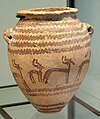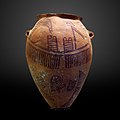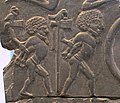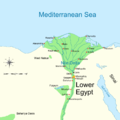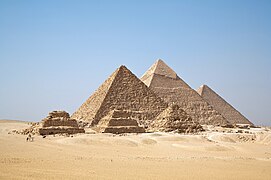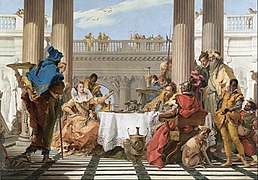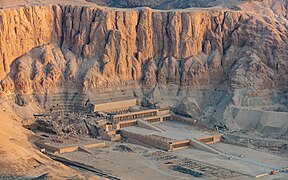
Back Portaal:Antieke Egipte Afrikaans بوابة:مصر القديمة Arabic بوابة:مصر الفرعونيه ARZ Portal:Qədim Misir Azerbaijani Портал:Египтопедия Bulgarian Portál:Starověký Egypt Czech Portal:Ägyptologie German Portalo:Egiptologio Esperanto Portal:Egiptología Spanish Portail:Égypte antique French
|
THE ANCIENT EGYPT PORTAL
Showcased content about Ancient Egypt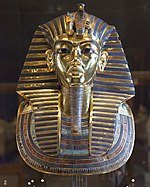 Ancient Egypt was a civilization of ancient Northeast Africa. It was concentrated along the lower reaches of the Nile River, situated in the place that is now the country Egypt. Ancient Egyptian civilization followed prehistoric Egypt and coalesced around 3100 BC (according to conventional Egyptian chronology) with the political unification of Upper and Lower Egypt under Menes (often identified with Narmer). The history of ancient Egypt unfolded as a series of stable kingdoms interspersed by periods of relative instability known as "Intermediate Periods". The various kingdoms fall into one of three categories: the Old Kingdom of the Early Bronze Age, the Middle Kingdom of the Middle Bronze Age, or the New Kingdom of the Late Bronze Age. Ancient Egypt reached the pinnacle of its power during the New Kingdom, ruling much of Nubia and a sizable portion of the Levant. After this period, it entered an era of slow decline. During the course of its history, ancient Egypt was invaded or conquered by a number of foreign powers, including the Hyksos, the Nubians, the Assyrians, the Achaemenid Persians, and the Macedonians under Alexander the Great. The Greek Ptolemaic Kingdom, formed in the aftermath of Alexander's death, ruled until 30 BC, when, under Cleopatra, it fell to the Roman Empire and became a Roman province. Egypt remained under Roman control until the 640s AD, when it was conquered by the Rashidun Caliphate. The success of ancient Egyptian civilization came partly from its ability to adapt to the conditions of the Nile River valley for agriculture. The predictable flooding and controlled irrigation of the fertile valley produced surplus crops, which supported a more dense population, and social development and culture. With resources to spare, the administration sponsored mineral exploitation of the valley and surrounding desert regions, the early development of an independent writing system, the organization of collective construction and agricultural projects, trade with surrounding regions, and a military intended to assert Egyptian dominance. Motivating and organizing these activities was a bureaucracy of elite scribes, religious leaders, and administrators under the control of a pharaoh, who ensured the cooperation and unity of the Egyptian people in the context of an elaborate system of religious beliefs.[1] The many achievements of the ancient Egyptians include the quarrying, surveying, and construction techniques that supported the building of monumental pyramids, temples, and obelisks; a system of mathematics, a practical and effective system of medicine, irrigation systems, and agricultural production techniques, the first known planked boats, Egyptian faience and glass technology, new forms of literature, and the earliest known peace treaty, made with the Hittites. Ancient Egypt has left a lasting legacy. Its art and architecture were widely copied, and its antiquities were carried off to far corners of the world. Its monumental ruins have inspired the imaginations of travelers and writers for millennia. A newfound respect for antiquities and excavations in the early modern period by Europeans and Egyptians has led to the scientific investigation of Egyptian civilization and a greater appreciation of its cultural legacy. (Full article...) Selected article - The writing systems used in ancient Egypt were deciphered in the early nineteenth century through the work of several European scholars, especially Jean-François Champollion and Thomas Young. Ancient Egyptian forms of writing, which included the hieroglyphic, hieratic and demotic scripts, ceased to be understood in the fourth and fifth centuries AD, as the Coptic alphabet was increasingly used in their place. Later generations' knowledge of the older scripts was based on the work of Greek and Roman authors whose understanding was faulty. It was thus widely believed that Egyptian scripts were exclusively ideographic, representing ideas rather than sounds, and even that hieroglyphs were an esoteric, mystical script rather than a means of recording a spoken language. Some attempts at decipherment by Islamic and European scholars in the Middle Ages and early modern times acknowledged the script might have a phonetic component, but perception of hieroglyphs as purely ideographic hampered efforts to understand them as late as the eighteenth century. The Rosetta Stone, discovered in 1799 by members of Napoleon Bonaparte's campaign in Egypt, bore a parallel text in hieroglyphic, demotic and Greek. It was hoped that the Egyptian text could be deciphered through its Greek translation, especially in combination with the evidence from the Coptic language, the last stage of the Egyptian language. Doing so proved difficult, despite halting progress made by Antoine-Isaac Silvestre de Sacy and Johan David Åkerblad. Young, building on their work, observed that demotic characters were derived from hieroglyphs and identified several of the phonetic signs in demotic. He also identified the meaning of many hieroglyphs, including phonetic glyphs in a cartouche containing the name of an Egyptian king of foreign origin, Ptolemy V. He was convinced, however, that phonetic hieroglyphs were used only in writing non-Egyptian words. In the early 1820s Champollion compared Ptolemy's cartouche with others and realised the hieroglyphic script was a mixture of phonetic and ideographic elements. His claims were initially met with scepticism and with accusations that he had taken ideas from Young without giving credit, but they gradually gained acceptance. Champollion went on to roughly identify the meanings of most phonetic hieroglyphs and establish much of the grammar and vocabulary of ancient Egyptian. Young, meanwhile, largely deciphered demotic using the Rosetta Stone in combination with other Greek and demotic parallel texts. (Full article...)Selected picture
Map of the Giza pyramid complex, located 20 km (12.5 mi) southwest of Cairo, Egypt. This Ancient Egyptian necropolis consists of the Great Pyramid, the Pyramid of Khafre, and the Pyramid of Menkaure, along with a number of smaller satellite edifices, known as "queens" pyramids, causeways and valley pyramids, and most noticeably the Great Sphinx. The site has attracted visitors and tourists since classical antiquity, when these Old Kingdom monuments were already over 2,000 years old. Did you know...
News5th September 2018. Rock-cut Tomb discovered in a 4,000-year-old Elite Cemetery August 2018: in the tomb of the mayor of Memphis Ptahmose who dates around 1300 BC was found well preserved cheese, more than 3000 years old. [1] Selected biography -Ptolemy VI Philometor (Greek: Πτολεμαῖος Φιλομήτωρ, Ptolemaĩos Philomḗtōr; 186–145 BC) was a Greek king of Ptolemaic Egypt who reigned from 180 to 164 BC and from 163 to 145 BC. He is often considered the last ruler of ancient Egypt when that state was still a major power. Ptolemy VI, the eldest son of King Ptolemy V and Queen Cleopatra I, came to the throne aged six when his father died in 180 BC. The kingdom was governed by regents: his mother until her death in 178 or 177 BC and then two of her associates, Eulaeus and Lenaeus, until 169 BC. From 170 BC, his sister-wife Cleopatra II and his younger brother Ptolemy VIII were co-rulers alongside him. Ptolemy VI's reign was characterised by external conflict with the Seleucid Empire over Syria and by internal conflict with his younger brother for control of the Ptolemaic monarchy. In the Sixth Syrian War (170–168 BC), the Ptolemaic forces were utterly defeated and Egypt was twice invaded by Seleucid armies. A few years after the Seleucid conflict ended, Ptolemy VIII succeeded in expelling Ptolemy VI from Egypt in 164 BC. (Full article...)General imagesThe following are images from various ancient Egypt-related articles on Wikipedia.
Related portalsWikiProjectsMain topics
Notable Pharaohs
CategoriesRecognized content
Featured articles
Featured listsGood articles
Did you know? articles
Featured pictures
In the News articlesMain page featured articles
Main page featured listsPicture of the day pictures
Things to do
WikimediaThe following Wikimedia Foundation sister projects provide more on this subject:
Sources
Discover Wikipedia using portals |
© MMXXIII Rich X Search. We shall prevail. All rights reserved. Rich X Search



